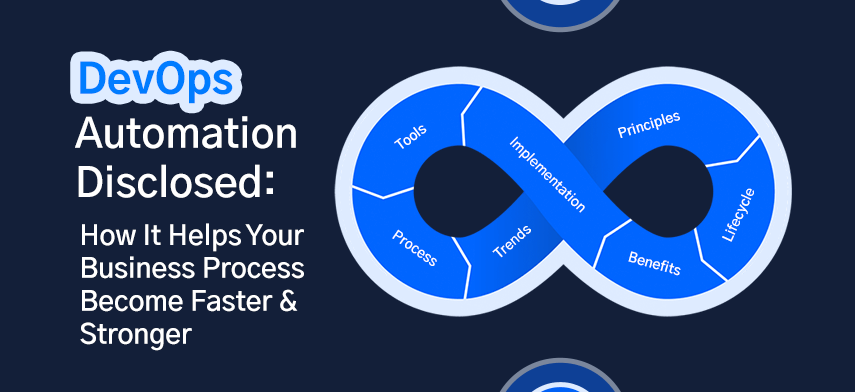DevOps is not new to the global business landscape. It has been used by Startups, SMBs, and legacy enterprises to build world-class products, applications, and digital solutions for many years now.

What makes it more important is its ability to bring software developers and IT operations teams under one roof alongside leveraging modern tools and practices to keep up with the latest technology trends and user expectations. But have you ever thought of automating these practices or the entire workflow?
Yes, we are talking about DevOps automation, an approach that is designed to break silos, regulate processes, and transform your vision into future-ready solutions.
Our today’s blog will discuss why automation is the need of the hour and the benefits you get by doing it. You will get some insights into the key steps of a typical DevOps lifecycle and how to make the most out of them. We will also understand what is DevOps automation and its key principles. But first, let’s first have a quick glance at the history of DevOps.
History of DevOps Process
In 2009, the term DevOps was first introduced at a conference by Patrick Debois, a consultant, project manager, and Agile practitioner from Belgium. Since then, enlightened and progressive IT experts have nurtured this concept in various disciplines. Two primary movements from which the DevOps process has been inherited are:
Agile System Administration Development
Agile software development is all about the close alliance of consumers, product management, product developers, and more. In the DevOps process, the principle of Agile system management gets acknowledged, and it outgrows the Agile principle beyond the limitations of code to complete delivered assistance.
Enterprise System Management (ESM)
Many people who once used to be system administrators are now involved in DevOps. They have brought important enterprise system management best practices to the DevOps process, including automated provisioning, configuration management, toolchain approach, system monitoring, and more.
To break the silos and inflexibilities among staff in companies, the introduction of DevOps happened long ago. It is getting more advanced day by day, automating end-to-end deployment, and encouraging an environment of responsibility and collaboration.
DevOps Trends
According to an industry analysis by Grand View Research, the DevOps market size is expected to grow annually by 18.60% by 2025. JFrog, a US-based software company, is already pioneering consumer experience through DevOps. Companies like Amazon, Netflix, Etsy, Walmart, etc., are implementing DevOps in their day-to-day processes to improve efficiency and ameliorate delivery time.
According to a survey, 38% of IT recruiters are looking to hire DevOps professionals, while 25% of software developers are willing to acquire DevOps skills. But that’s not all. The market will host an array of trends that are about to automate DevOps and transform the way we do business in today’s digital age.
Here are the top trends that you need to keep an eye on.
- Container technologies to explore custom resources and manage heavy applications.
- Serverless computing will simplify and automate the continuous deployment process.
- Microservices architecture will make IT processes faster, better, and more secure.
- Infrastructure as Code (IaC) will reduce the complexities of managing application and service infrastructures.
- Adoption of automation tools to handle massive amounts of data.
- DevSecOps will promote collaboration and facilitate out-of-the-box security initiatives.
In a nutshell, the combination of DevOps and automation is a rising trend, which is here to stay and help businesses achieve desired objectives.
DevOps Principles
After knowing the key DevOps facts and trends, it is time to understand the methods and principles that can help you achieve the right DevOps automation culture among your teams and for your organization.
Create a Collaborative Atmosphere in the Organization
Encourage your operation and development teams to get out of silos and collaborate with each other. Make sure they communicate, share knowledge, and solve problems together. Only then you will follow the main purpose of using DevOps, uniting workers, and meeting consumer needs with combined efforts.
Develop End-to-end Responsibilities in the Team
From ideas to implementations, make sure your development and operation teams have end-to-end responsibilities and accountability for the application. This will help in getting more things done in less time with maximum efficiency.
Adapt to the Continuous Improvement Process
You should keep tabs on updates on technologies, change in consumer needs, etc. DevOps supports continuous improvements and helps in automation, optimization of cost, and improvement of delivery speed.
Trust Automation
Experts believe that automation is an important step for releasing software to customers. It makes the release process quick and hassle-free. Your DevOps teams can create their own process of automation. Support them to perform everything successfully.
Keep Customers’ Needs Top Priority
Make sure your teams focus on meeting the ever-changing requirements of customers. Data collected from the automation process should be continuously reviewed to make sure that the performance targets are being met. If a strategy is not working anymore, your team should be prepared to update a new one. And never think twice to invest in features that can meet consumer satisfaction.
Unify Team & Appreciate Everyone’s Expertise
In a DevOps project management process, all the teams should be involved across all stages. Make sure your team is cross-functional and has a balanced set of expertise. Encourage the team to share knowledge and responsibility with each other.
Lifecycle of DevOps
You can rightly exploit the above principles only when you have a proper roadmap for your DevOps automation project. Let’s check out the steps involved in a typical DevOps lifecycle to give you a better idea.
#Step1: Development
This step involves planning and software coding. Planning signifies the complete understandability of a project’s objectives and coding focuses on developing the application with respect to the target audience.
#Step2: Integration
This step involves various aspects, such as planning further tests after development and understanding the coding language to deliver the outcome as required in the primary project documentation.
#Step3: Testing
In a continuous testing step, you can test the application in a real environment. It will help you get various aspects of the same application, which will eventually improve the further development process.
#Step4: Monitoring
In this step, you can constantly monitor the application’s performance, keep tabs on it, identify any problem area, and make modifications as needed.
#Step5: Feedback
Here, any kind of modification or improvement gets analyzed. Your developers can measure the outcome of the final result. Also, customers can share their user experience.
#Step6: Deployment
In this step, the code gets deployed into a Cloud server for further use. It makes sure that the code modifications should not affect the functioning of the high-traffic website.
#Step7: Operation
This step is based on automating the release of the app and its following updates. It enables DevOps companies to make the most of the time to market continuously.
In the DevOps automation framework, continuity plays a vital role in making the entire process fast and seamless. With this, you can create software applications or improve the efficiency of an already existing product.

What is Automation in DevOps?
When it comes to software development, automating DevOps is all about putting an end to recurring, complex, and time-consuming processes – from code generation and deployment to configuration and continuous monitoring. There are various technologies and processes available across the market including artificial intelligence, machine learning, deep learning, robotic process automation, IT automation, and more that can help you automate your DevOps processes to their best.
DevOps automation will help you make your processes more efficient and faster. It will enable your developers and operations teams to create, test, deploy, and maintain applications with less exposure to manual practices. Altogether, it will help you deliver continuous integration (CI) and continuous delivery/ deployment (CD) pipelines without compromising on quality.
Benefits of DevOps Automation
If you incorporate DevOps automation best practices in your daily business operation, you get aligned with a series of benefits that will take your business to the next level. Let’s check them out one by one.
Fast Delivery
DevOps automation platform accelerates your software development life cycle (SDLC). It provides the scope for fast and continuous feedback alongside facilitating quick pivoting and iteration.
Alliance between Teams
With DevOps automation in place, your company gets the privilege to improve business agility by maintaining an environment of mutual alliance, communication, and coordination among in-house as well as extended teams.
Better Consumer Experience
Automating DevOps improves the deployment rate and minimizes the change failure rate. Prioritizing automation ensures the reliability and stability of a software application after each new release.
Early Fault Identification
By automating the process of monitoring and testing the code, your developers and operations teams will be able to identify and remove potential bugs, glitches, or any other system vulnerabilities beforehand.
Continuous Release & Deployment
You can incorporate DevOps automation CICD practices into your organization to render continuous release and deployment for your desired application with minimal human intervention.
Scalability
Automation helps you take full advantage of advanced, cloud-based technologies that offer unmatched scalability. You will be able to scale up your application or its features and functionalities when required with ease.
How to Implement Automation in DevOps?
You can reap all the above benefits only when you rightly implement automation within your DevOps practices and methodologies. This will not only optimize your team efforts but also help you identify what works best for your company.
Here are some tips to help you out.
- Prioritize automating common processes within your DevOps pipeline including software testing, infrastructure management, monitoring, and reporting.
- Optimize your CI/ CD initiatives to ensure needed productivity and interoperability.
- Practice log management in real, controlled environments for your web or mobile application.
- Opt for a DevOps automation services that provides end-to-end support for frequent releases.
- Focus on reusable code and strategies.
- Use necessary automation tools that facilitate a more efficient DevOps workflow.
DevOps Automation Tools
There are various tools that you can opt for, depending on your DevOps workflow automation requirements and expected outcomes. We have compiled the most commonly used tools by various companies across the globe.
Testing Tools
These tools are very crucial for automating application tests, deploying their new versions, and/or checking when an application is ready to be released. They replace human interaction with dedicated automated testing. They help you configure servers and observe continuous app integration without raising any complexities.
DevOps Toolchain
This is considered a system including multiple tools. All the tools in a toolchain function together to help in automating an app development and delivery process. It outlines various aspects including coding, developing, testing, packaging, releasing, configuring, and monitoring.
Security Tools
These tools ensure the security of applications and reduce the time to market. They keep applications free from potential threats and unwanted situations. Usage of these tools eases your team’s workload by managing the necessary tasks, like debugging, monitoring file integrity, installing, etc.
Facilitating Collaboration
They should help you improve collaboration between teams. Therefore, before choosing, look for the main purpose of a tool to find out its collaboration opportunities.
Having API
Tools, backed by a fully featured API, can be both automatable and customizable. These tools perform one or multiple tasks perfectly and then integrate the rest with other technologies. They are flexible enough to adapt to new updates.
Being able to store all configuration settings in version control
In DevOps, all configuration settings should be stored in version control. These configuration settings include both your custom software app and the tools to be used in software app delivery and IT operations. Make sure your selected tool exposes its configuration to version control and helps you keep track of all the configuration and test updates beforehand.
Is there any apt way to choose the right tools that will work best for your team? Of course, there is. Here are some important factors to consider before making a pick.
The Final Words
With all the above, you would have surely understood the importance of DevOps automation and why you should choose it in the first place. If you are planning to automate your business processes but are not sure where to start, you can outsource your requirements to Mobisoft and accelerate your digital transformation journey to its fullest. Our seasoned DevOps experts are committed to extending required services that will help you launch applications and solutions your users would love to interact with.

Author's Bio:

Pritam Barhate, with an experience of 14+ years in technology, heads Technology Innovation at Mobisoft Infotech. He has a rich experience in design and development. He has been a consultant for a variety of industries and startups. At Mobisoft Infotech, he primarily focuses on technology resources and develops the most advanced solutions.


 Ill Patients">
Ill Patients">